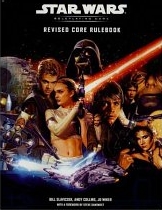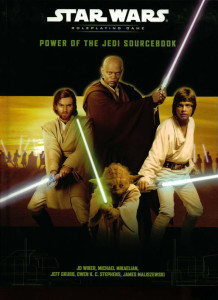

This version of the SW RPG was actually the second I played. I picked up the original WotC version, now known as OCR, a few months before they released the RCR. This core book was the one I used for most of the first SW campaign I ran, borrowing from RPGA Living Force. Looking back, it wasn’t a very good campaign and I still feel like I was an awful GM. But those things are way, way less important than the fun fact, that, fourteen or fifteen years later, I am still having fun playing SWRPGs – all five versions (OCR, RCR, D6/WEG, SWSE and FFG) over that timespan. I even loved them enough to once more try my hand at GMing and am still having a ball whichever side of the GM screen I’m on. So now I am looking back at the system, specifically its handling of the Force and Force-sensitives, where I took my first steps into a much larger galaxy of RPGs.
WotC Star Wars originated the division of Jedi into Jedi Consular (diplomats, healers, etc.) and Jedi Guardian (warriors) classes, which were adopted later by many of the video games. There was also a third, Force Adept, to represent Force-users who were neither Jedi nor Sith, such as Dathomiri “witches.” In the core book, Adept was only suitable for characters from primitive cultures. A later sourcebook would include an archetype (suggested multiclass progression) for those from an urban or advanced background. Typical of D20 games of the time, multiclassing, other than into Prestige Classes (PrCs), was discouraged by mechanical penalties; in fact, you could not multiclass into the other Jedi base class per RAW (although multiclassing to or from Force Adept was allowed). Like D6 before it, Force abilities were classed as Control, Sense or Alter. In RCR the trio were represented mechanically as Force Feats. All other Force Feats had at least one of these as a prerequisite.

RCR used mechanics as the main way of balancing Force PCs, although there were also roleplaying balances. Of course, there was the rule – traditional in SWRPGs previous to FFG – that PCs who fell to the Darkside became NPCs. But many other mechanics were at work here. First, Skills and Feats were divided into Force (prerequisite: Force-sensitive PC) and those available to all characters. Although they were considered Class Skills, Force Skills (which covered various Jedi arts like Affect Mind, Move Object, Heal, etc.) had to be purchased out of the same pool of points as general skills (Piloting, Treat Injury, Diplomacy, etc.), meaning Force PCs who wanted to have a lot of Jedi abilities at more than minimal ranks would have less points to buy up, or buy more, general skills. Likewise, Force Feats had to be taken instead of a normal feat (with the exception of Alter, Control and Sense which were gained as class Force Training benefits). Even class bonus feat lists had few if any Force Feats.
Then the Vitality/Wound Point (VP/WP) system acted as another balance. Non-Force PCs generally only lost VPs due to damage and a few other effects but VPs also powered most Force skills. Even a mid-level Force PC could blow through a lot of VP wielding the Force, meaning that in combat they had fewer to absorb damage before it started coming out of WPs, putting the character at risk of dying status sooner than the Scoundrels, Soldiers or Nobles in the party. The ban on having both Consular and Guardian class levels acted as another, lesser balance, since that would give a Jedi PC a wider variety of class features.
Much of the Force chapter in the Core book, other than Force Points, Darkside Points (DSPs) and Lightsaber construction is fluff, borrowing heavily from the Tales of the Jedi. The section on the Jedi Code, for example covers pretty much all of Master Odan-Urr’s contributions to the Code, complete with many quotes. Other well-known aspects of the Expanded Universe(EU)/Legends (events, species) are covered both here and in the Power of the Jedi (PotJ) sourcebook. Those other influences range from Ruusan to post-RotJ eras. Since the source materials are so familiar to so many players, I am not going into detail. Like all WotC SWRPG iterations, RCR books had many pages devoted to “Iconic Characters,” those from the movies and then-EU (now Legends). Most players that I know of, myself included, made little use of the Iconics, as SWRPGs are meant to allow you to tell SW stories about characters belonging to you and your friends. But the RCR line also added to the EU. For example, PotJ developers didn’t invent the Jedi Service Corps, the first mention being AgriCorps in the 1999 young adult novel The Rising Force. However, additional Service Corps and most details about them, beyond providing a place for aspiring Jedi who didn’t become Padawans, were originally created for PotJ.
Information on the Dark Side of the Force – other than DSPs, opponents and a few Force Skills/Feats like Force Lightning – was lacking, compared to OCR, SWSE or FFG’s Force & Destiny. PotJ, as the name implied, was focused on Jedi and the Lightside. Many of its new Force Skills and Feats were Lightside only and/or usable only by those with zero or one DSP. Many of us hoped for the release of an RCR version of OCR’s The Dark Side Sourcebook, but that never happened due to the advent of SWSE. As always, GMs made up for the lack with their own homebrew conversions, stats and mechanics.
I am unlikely to play more RCR SW, but that isn’t because it wasn’t a good game. It gave me a lot of memories, kept me playing Star Wars and started at least one valued friendship – which is far more than “pretty good” in my book. And the books still have a place on my bookshelf.
Linda Whitson
Latest posts by Linda Whitson (see all)
- Astral Projections – The Ripperdoc Is In - May 8, 2023
